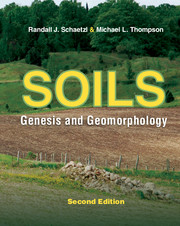Preface
Published online by Cambridge University Press: 12 January 2024
Summary
This book is about pedogenesis and soil geography. To some, this is a difficult and challenging area of study, because a geographic approach to soils requires synthesis of the many physical, chemical, and biological systems that have interacted to form the soils that blanket most landscapes. Plus, these landscapes change through time. Our purpose in writing this book is to assert that only through a study of the spatial interactions of soils on landscapes can soil and landscape evolution be resolved and understood.
This book can be used in courses on soil geography, soil genesis, pedology, and soil geomorphology. Our assumption is that the readers have had some background in the natural sciences and are eager to learn more about soils. We do not assume, nor does the reader need, a substantial background in soils to read and comprehend this book. Difficult as the task may seem, our goal was to write a soils text that could serve both as an initial soils text and as a cutting-edge resource book of research grade.
Our emphasis, beyond that of pedogenesis and soil geography, is deliberately intended to be broad and comprehensive. Other similar books (Daniels and Hammer 1992, Gerrard 1992, Birkeland 1999) focus more on geomorphology and the initial geologic setting as a guiding framework for the understanding of soil landscape evolution. We emphasize these issues in later chapters. Fanning and Fanning (1989) and Buol et al. (2011) focus on soil genesis while emphasizing classification. Our book tries to walk the middle ground amid these approaches to the study of soils.
This book relies heavily on concepts and imagery – mental and graphical – to convey ideas. We have compiled a suite of figures, images, and graphics that, in and of themselves, convey messages that cannot be put into words. Throughout the text we include brief “out-takes” on soil landscapes from around the world. We call these excursions “Landscapes,” and hope that they convey, with pictures and graphics, what would otherwise take many hundreds of words to explain.
We believe in the necessity and importance of soil classification; we define, explain, and use its terminology in the book, but we do not focus on it.
- Type
- Chapter
- Information
- SoilsGenesis and Geomorphology, pp. xvii - xviiiPublisher: Cambridge University PressPrint publication year: 2015



